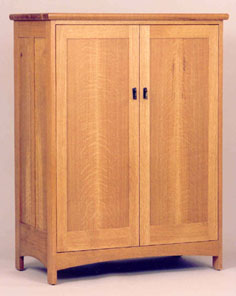
Peter Ribotto keeps busy. His work is in demand by homeowners and architects throughout the Twin Cities of Minnesota. He’s on the board of the Minnesota Woodworker’s Guild, and his work has been displayed several times at the prestigious Northern Woods Exhibition in Minneapolis. Pretty good for a guy who describes himself as a self-taught woodworker.
But he’s always been a do-it-yourselfer and as a kid spent more time in his dad’s small shop than his dad did. His first big project was the second story to a tree fort that he built when he was only 13 years old.
“It lasted for some 25 years,” Peter recalled, “and only when my brother sold the property did he decide they’d better take it down before some neighbor kid decided to climb up there.”
Though a native of the upper peninsula of Michigan, he attended high school in a mining town in northern Ontario. There he had access to a great shop, although a lot of the instruction was on what not to do.
“They’d say ‘See that lathe over there – never touch that,'” Peter explained, “So I never did learn how to use a lathe, and to this day I don’t do any turning. And even today, if a leg needs to be shaped, I’ll band saw it and plane it.”
A job in mining eventually brought Peter to Minnesota’s Iron Range. Inspired by articles in Popular Mechanics, he set up his first workshop in a 10′ by 12’ shed with only a small table and radial saws and some hand tools. Early projects included some bookcases and what he calls a “pretty poor excuse for a grandfather clock” out of “amazingly wet black ash.” According to Peter, his early interest in woodworking was based on both necessity and choice. He liked to see the results of having done it himself, and he liked the financial savings that went along with it. Then, in the early 80s, he came upon the books of James Krenov.
“I bought his books when they were in their first editions, and I used to spend the summer reading them & I ended up reading each several times. I tried to apply some of what he did. Some of it you can use and some of it you can’t. After that I bought all the Fine Woodworking books and read through them.”
By 1986, he’d set up a new shop in his basement and, through his association with a small Duluth woodworking guild, heard that Sam Maloof was putting on a seminar at the Minneapolis College of Art and Design. Coming down to the Twin Cities for the Saturday seminar, he watched the master woodworker practically build an entire armchair in one day.
“He would work and talk to us, and then would work and talk to us some more. It was great,” Peter noted.
In 1993, the declining mining industry convinced Peter to move to the Twin Cities area and change careers. While still working full-time, he went back to school and eventually started a new career as an investment accountant. He also began to acquire more woodworking tools, and in 1995 attended the Northern Woods Exhibition sponsored by the Minnesota Woodworker’s Guild. He soon joined the guild and entered his piece in the exhibition.
“Then somebody asked me if I would be on the committee for the exhibition, and from there they asked me to be on the board,” Peter recalled, “and I’ve been on the committee and the board ever since.”
Peter described the effect joining the guild had on his woodworking: “First of all, it scares you to death that there’s all this fine quality woodworking out there. Then it makes you wonder if you can apply some of the things you’re seeing.”
His work was included in the exhibition that first year and in several subsequent shows. The exposure brought him commissions from both individuals and architecture firms. Almost all his work today is done for commissions, and that’s the way he likes it.
“I don’t want to build something just to put it in a show, because then where would I put it? The practical side of me always needs a purpose before anything gets built. My work is client-driven.”
He defines most of his commission work as pretty decent cabinetmaking rather than fine woodworking, meaning he uses sheet goods rather than solid wood, and the joinery is usually pretty simple.
“Occasionally, I’ll get a chance to do a really nice piece, but most of my commissions are not show quality. Plus, being vice president, treasurer and membership director for our 800+ member guild, I just don’t have as much time for fine woodworking.”
Not that he hasn’t kept busy. He’s just finished a kitchen for one client and a vanity for another. Currently he’s working on some bookcases that will be built into a town home; designing a red oak entertainment center (it will have a Mission look, but he’s still debating about having a Harvey Ellis curve on the bottom); and perfecting the design for a split-top coffee table.





